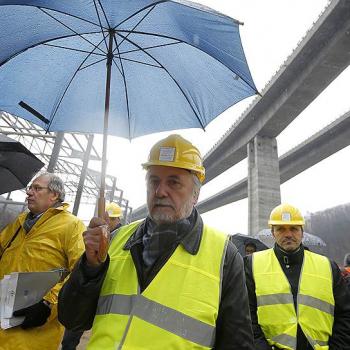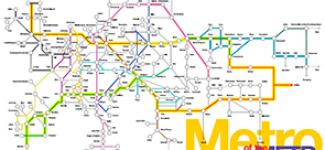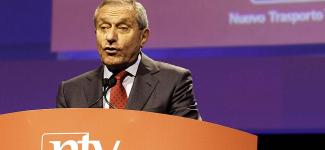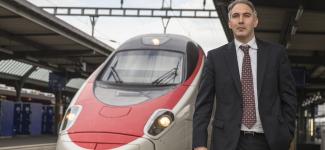Home › Projects › White Book › Environmentally compatible transport infrastructure
Environmentally compatible transport infrastructure

High speed railways as the balance point between increasing mobility and providing for environmental protection
Mario Virano, Special Commissioner for the Turin–Lyon high-speed railway at the Italian government, explains how to find balance between mobility growth and environmental sustainability.
In his book A Brief History Of The Future Jacques Attali describes increasing rivalry between those who are prone to moving from place to place (so-called nomads) and those who prefer a settled way of life. In the years to come this structural peculiarity of the modern world will only escalate. The question of interaction between nomads, who travel around in search of anything new and make hundreds of acquaintances along their way, and people who see every encounter with “aliens” as an attempt on their identity and lifestyle is not only about the displaced or refugees; it also often leads to divisions in the “relationships” between the transport infrastructure and the environment.
Despite the fact that transport’s environmental impact is often criticized, mobility is undoubtedly one of the fundamental values in modern society that brings immense opportunities as far as business and personal relations are concerned. A city’s, region’s or even country’s accessibility or integration into the overall transport system frequently works as the key factor defining how attractive it is. To satisfy the demand on mobility without damaging the environment we must make decisions aimed at securing environmental sustainability or, in other words, creating opportunities for today’s generation without creating new challenges for generations to come. In a world where passenger flow growth comes together with emerging economies’ development balancing the mobility growth and its effect on limited natural resources is of utmost importance.
Within the framework of the large-scale TEN-T transport infrastructure projects the European Union looks first and foremost to provide for public approval of its tasks and methods including those that affect the METR region both in terms of member state unity based approaches and market integration. Transport corridors shape the future links between different parts of the union, prioritizing urban infrastructure objects, ports and airports.
Many of these corridors are rooted in history and culture and today are just refurbished to keep up with the time. They include both the ancient routes originally followed by merchants and pilgrims (Via Francigena, Silk Road, Imperial Indian mail track) and the new routes emerging as part of geo-political integration or border elimination strategies aiming to create a global economy space.
But no matter what their origin is, such multi-functional corridors concentrate financial flows, activities and projects along certain lines and require clear definition of priorities (goals and rules) both on the national and international level. Territorial issues must be considered with complex approach that takes into account the macroeconomic conditions and the common goal of social and territorial integration.
But there are other important matters, and one of the most significant ones is building up a set of rules accepted by all countries in the region. It is obvious that in order to guarantee maximum mobility within an area measuring thousands of square kilometers common standards must be followed throughout the whole zone. Interplay between different member states’ transport network branches as well as passenger rights and safety must be provided for and common market access and competition as stipulated by the EEC Treaty must be enacted.
This factor is hardly self-evident, but certainly vital: the very idea of multi-functional strategic continental transport networks is viable only as long as basic transport rules are gradually standardized. But it’s not only the basic parameters like engine power output, gauge width, signal and control systems etc. that must be adjusted in compliance with common regulations. Common criteria of financial and economy parameters (a certain codex regulating investment decisions through benefit and expenditure analysis) must also be introduced. These include discount rates, project returns estimation criteria, time saving for various groups of operators and external factor (first of all, environmental) pricing quantification. The latter can theoretically show whether local authorities are willing to pay a certain price for saving their natural resources with no mobility drawbacks.
Europe is unlikely to see endogenous demographic increase, but it attracts massive streams of migrants from world’s poorest and least stable regions, which leads to various integration, coexistence and national identity-related issues. It should be pointed out that the European identity is based on cities, which account for 50–75% of the population. Europe’s urban space consists of middle-sized cities, most of which have a long history.
There are only two megalopolises in the EU itself, which are Paris and London, but if we take a look at the larger METR region picture, we’ll see two more – namely, Moscow and Istanbul. Outside these the competitiveness is provided for by urban agglomerations (a number of separate, yet closely connected cities like the Belgian, Dutch, various English and German clusters and the Po Valley in Italy) that are the main driver for production growth and technological progress. These work as integrated territorial systems and become increasingly competitive due to the fact that their member-cities turn into so-called “smart cities” and join the integrated high-speed high-practicability transport system. This means that it takes less time to get from one city to another than to cross the whole agglomeration in one go.
The TEN-T project, which is to cover 17 000 km by 2030, is aimed to create high-speed railway links between European cities. However, it is not only about guaranteeing citizen mobility on the scale of a continent, but also about preserving and enriching the environment in terms of its historic and cultural diversity. It is obvious that as long as no high-speed transport connection capable of making intercity travels as easy and comfortable as the intra-urban ones is established, all we will see is people leaving underdeveloped areas to move into the more developed ones. This will result in megalopolis population density increase beyond control on the one hand and downturn suffered by other regions on the other.
As opposed to this prospect, the well-balanced, polycentric European model of territorial and social organization integrated through multi-functional high-speed transport corridors will work as an urban macro system featuring rich natural resource deposits like the Alps, resembling an inter-continental subway with nine lines and cities as stations.
The 2011 EU White Paper outlines the prospects of transport and environmental development up to 2050, with increasing citizen mobility while taking its ecological impact into account as fundamental priority.
The strategy is based on 4 key principles that are:
- Increasing transport’s energy efficiency by improving engine and fuel steady response,
- Increasing the efficiency of logistical chains by making use of transport infrastructure and sustainable transportation means,
- Introducing innovative technologies to manage and optimize the transport flow,
- Guaranteeing competitiveness and market development.
These are the main ideas of the new concept of the environment that sees it as a phenomena which can be made use of, incorporates the rights of people living in it (including the right for mobility) and permits adjusting the key factors behind carbon emissions which cause the global change in order to reduce those as opposed to regarding the environment as a pre- or post-anthropologic absolute.
The program pays much attention to the qualitative aspects of freight corridors. In particular, it stipulates a gradual shift from wheeled motor transport to more eco-friendly options. Other tasks include shifting to lower-carbon fuel in aviation (up to 40% of its overall energy demand) and cutting shipping CO2 emissions. Both tasks are to be accomplished by 2050, while the 50% traditional fuel use reduction in urban transport will become reality as early as in 2030.
The White Paper sets no qualitative standards for the rail transport as far as emission cuts or complex restructuring are concerned, but it does set prioritized directions in the development of this industry. Goal 4 is to triplicate the overall length of high-speed rail lines while maintaining the existing branched rail networks in all member-states by 2030; by 2050, the all-European high-speed rail network must be completed and larger part of the middle-distance passenger flow must be allocated to rail transport. Goal 5 is to finish the main multi-functional TEN-T network on the whole EU territory by 2030 and bring the complete high-quality high-capacity network with corresponding information services online by 2050. Goal 6 is to establish rail (first and foremost high speed rail) links between all major airports in the network and provide access to rail freight and, if possible, inland waterline systems to all seaports.
Europe also sets two extra environmental tasks: 1) to ”encourage business-based GHG certification schemes and develop common EU standards in order to estimate the carbon footprint of each passenger and freight journey with versions adapted to different users such as companies and individuals”; 2) to establish international tariffs based on payment-for-use and who-pollutes-pays principles and the set of regulations designed in 1998.
Despite the global financial crisis and multiple local political conflicts the METR region still enjoys bright future prospects. One of the most notable challenges it is currently facing is the ambitious plan to introduce the specific environmental compatibility estimation to the design of transport corridors relating to the historic and geographic (both geopolitical and geomorphologic) conditions of the lands they cross. The EU model of multifunctional transnational transport corridors seems to be the most advisable here. The reason for that is that it allows direct interstate negotiations on how transport connections will be organized, which are of utmost necessity when building a high-speed railway, stipulates signing international agreements to set target rules for such corridors including special permissions system, special categories, special compensational mechanisms as an extra financing source and, finally, establishing special taxation zones at the beginning and the end of the logistical cycle.
At this point, some light should be cast on the possible scenarios of the region’s political and economic development. It seems advisable to provide access to the METR region transport corridor market for international operators working together with local companies. Russia allowed it for the enterprises that won the PPP highway construction tendering, and so did Turkey, where international capital and know-how stimulated the country’s infrastructure development by revealing its true potential and showing the way it can be realized. All these tasks can be completed without breaching any EU eco standards: sustainable development does not result in decreasing mobility, but, on the contrary, leads to increased efficiency, integration and interaction, use of renewable energy sources, functional balance and technological innovations.
To achieve higher environmental compatibility, all future transport corridor construction projects should be built around five fundamental factors as top priorities:
- The environmental factor, i.e. the level of pollutant emissions and the overall carbon threshold for the whole project lifetime,
- The territorial factor, that includes estimations and viewpoints of all interested parties (for example, sticking to the relevant agreement on involvement and information between the EU and Russia),
- Coordinated and orderly effort to secure environmental protection along the whole length of the corridor by working out procedures, norms and regulations similar to the standards the EU has designed while bringing together the industrial policies of its member states,
- Clear and transparent international procedures regarding economic activity’s environmental impact incorporating tariffs for using the infrastructure, profit and loss CO2 ratio index,
- Boosting the role of the private sector on all stages from project design to its construction and operation to create a common METR transport space.
- In this regard the METR high speed rail lines can follow the latest developments in international practice. Standards and procedures vary from country to country. But the common feature is that the popular opinion should be taken into account before the construction is under way. As far as environmental protection is concerned, the 2009 Deutche Bahn is noteworthy due to being the first railway project with zero carbon emissions; this was achieved by using only renewable energy sources on a certain sector.
Going back to the METR project, it should be pointed out that developing a new fully environmentally compatible transport infrastructure capable of taking into account all local historical, political and cultural peculiarities based on the advanced international practice seems to be quite possible. For the large-scale international construction project to succeed, it should be based on various agreements between member states including technical specifications and regulations as well as economical, financial and operational documents.
http://www.kommersant.ru/doc/2448369
Sign up for MIR initiative email updates
Sign up to receive monthly notifications about new arctiles published and other events on your email.






